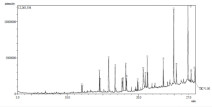Studies on Medicinal Chemistry Potentials of Hannoa undulata Essential Oil
https://doi.org/10.51412/psnnjp.2022.34
Keywords:
Ethno-pharmaceuticals, natural products, phytochemistry, PlantAbstract
Background: Hannoa undulata is a woody tree and shrub that belong to the family of Simaroubaceae. It is a perennial plant distributed in tropical and subtropical region of Africa. The plant is known for its medicinal value and the potency according to tradomedicine practitioners is very tremendous. The plant is acclaimed to be use in treatment of verse array of ailments viz: cancer, leprosy, tuberculosis, insanity, dementia, viral infection and prevention of abscesses in children among others. Due to the
acclaimed therapeutic uses of the plant, this study was aimed at determining the possible bioactive components of leaves and barks of H. undulata using GC-MS analysis.
Methods: The fresh leaves and bark stems of H. undulata were obtained from the plant and shade dried at room temperature. The dried leaves and bark stems were minced into fine powder. The bioactive combinations were done by GC-MS.
Results: The mass spectrum of the compounds found in the essential oils were matched with the National Institute of Standards and Technology (NIST) library Nine and twenty one phytocompounds were identified in the methanol leaf and bark stem extracts of the plant respectively. The major chemical constituents of the leaf include; 3,3-dimethoxyprop-1-en-1-ylium (4.77%), 5-methyl-1,3-oxazolidin-2-one (6.23%), furan-2-carboxylic acid (8.16%), ethyl palmitate (8.89%), 9,12,15-octadecatrien-1-ol (12.44%), hexadecanoic acid (17.86%), 7, 10,13-octadecatrien-1-ol (36.89%) while that of the bark are hexadec-14-en-1-ylium (6.69%), oleic acid (9-octadecenoic acid) (8.17%), hexadec-15-en-1-ylium (9.12%), di-n-octyl phthalate (16.14%), 3-(hydroxy {2-[(2-methylpropoxy) carbonyl] phenyl} methoxy)-2-methylprop-1-ylium (16.51%).
Conclusion: The presence of these compounds in the plant extract may be conscientious for the pharmacological properties of H. undulata and thus recommended as plant of phytopharmaceutical importance.
References
Uraku, A.J (2016). GC/MS Determination of Bioactive Constituents of Methanol Fraction of Spilanthes uliginosa (Sw) Leaves.
Research Journal of Medicinal Plant, 10 (1): 42- 54. DOI: 10.3923/rjmp.2016.42.54
Jothy, S.L, Torey, A, Darah, I, Choong, Y.S, Saravanan, D, Chen, Y, Latha, L.Y, Deivanai, S., Sasidharan, S (2012).Cassia spectabilis: A
promising traditional herbin health improvement. Molecules (17)6:10292–10305.
Casuga, F.P., Castillo, A.L., Corpuz, M.J.T (2016). GC–MS analysis of bioactive compounds present in different extracts of an endemic plant Broussonetia luzonica (Blanco) (Moraceae) leaves. Asian Pacific Journal of Tropical Biomedicine, 6(11): 957-961
Longbap, BD, Ushie, OA, Ogah, E., Kendenson, AC, Nyikyaa, JT (2018). Phytochemical Screening and Quantitative Determination of Phytochemicals in Leaf Extracts of Hannoa undulata. International Journal of Medicinal Plants and Natural Products (IJMPNP), 4 (2); 32-
8 . h t t p : / / d x . d o i . o rg / 1 0 . 2 0 4 3 1 / 2 4 5 4 - 7999.0402005
Shomkegh, S.A, Mbakwe, R and Dagba, B.I (2016). Utilization of Wild Plants for Medicinal Purposes in Selected Tiv Communities of Benue State, Nigeria: An Ethnobotanical Approach, European Journal of Medicinal Plants14(4): 1-14
Savithramma, N.M, Linga, R. and Prabha, B (2011). Phytochemical Studies of Dysophyllamyosuroides (Roth.) Benth. In. Wall. And Talinum cuneifolium (Vahl.) Willd.Research Journal of Phytochemistry, 5: 163-169
Jean-Claude, P and Jean-Michel, K (1985). Effects of quassinoids extracted from Hannoa undulate seed on the penetration and reproduction of Meloidogyne javanicaon tomato. Revue Nématol.,8 (4) : 383-389
NIST. Automated mass spectral library with search program (Data version: NIST11, version 2.0). National Institute of Standards and
Technology, (2010): Gaithersburg, MD., USA
Duke's Phytochemical and EthnobotanicalDatabase (2014). Available: http://www.arsgrin.gov/cgibin/ duke/ethnobot/
Ijioma S.N., Igwe K. K., Nwakudu O.N., Madubuike A.J., Achi N.K (2017). Preliminary evaluation of phytochemicals in Iresine
herbistiiethanol leaf extract using gas chromatography-mass spectrometry analysis. Journal of Environment and Life Sciences, 2 (1):
-2
AADC (2015). Human Metabolome database. Retrieved 17 February 2015.
Young, S.N (2007). How to increase serotonin in the human brain without drugs. RevPsychiatr Neurosci., 32(6): 394–9.
Duke's Phytochemical and Ethnobotanical Databases (1992-1996). U.S. Department of Agriculture, Agricultural Research Service.
Available:http://phytochem.nal.usda.gov
Feizi, T (1993). Oligosaccharides that mediate mammalian cell-cell adhesion. Current Opinion in Structural Biology, 3(5): 701–10.
Stryer, L (1995). Glycolysis. In: Biochemistry. (Fourth ed.). New York: W.H. Freeman and Company; 483–508.
Förstermann, U and Sessa, W.C (2011). Nitric oxide synthases: regulation and function, Eur.Heart J. 33 (7); 829–837
Kavoussi, P.K, Smith, R.P, Oliver, J.L, Costabile, R.A, Steers, W.D, Brown-Steinke, K, de Ronde, K, Lysiak, J.J, Palmer, L.A, (2018). Snitrosylation of endothelial nitric oxide synthase impacts erectile function, Int. J. Impotence Res. 20; 1.

Views | PDF Downloads:
706
/ 317
/ 0
Published
How to Cite
Issue
Section
License

This work is licensed under a Creative Commons Attribution-NonCommercial 4.0 International License.


